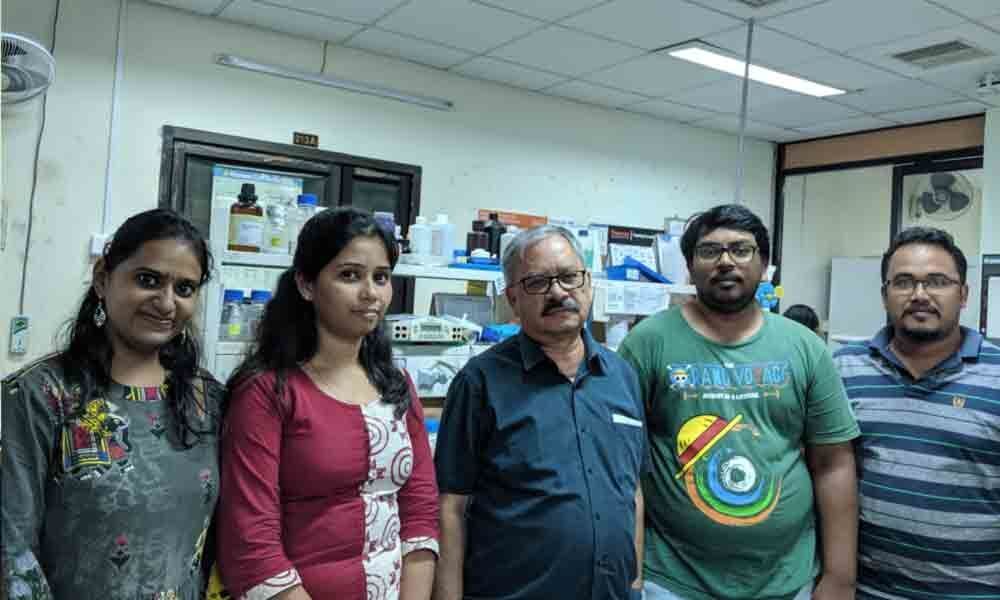Live
- Hyderabad: Eatala, Raghunandan, DK Aruna file nomination papers
- Chandrababu to hold Praja Galam election campaign in Kurnool today
- Rajasthan CM casts his vote, says BJP will repeat history
- Ex-MP CM Kamal Nath, son Nakul Nath cast votes in Chhindwara
- Hyderabad: HC directs police to permit Hanuman Vijaya Yatra rally with 100 bikes on April 23
- LS polls: PM Modi to campaign in UP, MP and Maharashtra today
- ‘Narmada Pushkara Kshetra Darsini’ book released
- Gold rates in Delhi slashes, check the rates on 19 April 2024
- Gold rates in Visakhapatnam slashes, check the rates on 19 April 2024
- Filing of nomination commences
Just In
IIT-Madras researchers obtain giant cancer cells for research


Stem cells obtained using microgravity can be used to understand the nature of cancer cells, their proliferation, and cell death pathways, which can help in identification of target zones for drug development
Chennai: Indian Institute of Technology Madras researchers have found that subjecting cancer cells to microgravity results in the formation of giant cancer cells with stem-cell characteristics. These cells can conceivably be used for cancer research and drug development.
Stem cells are difficult to isolate and grow. Cancer Stem Cells (CSC) generally make up just 1 per cent to 3 per cent of all cells in a tumour. Research is being conducted all over the world to extract and culture CSCs for cancer understanding and drug development.
The research was led by Prof Rama S. Verma, Stem Cell and Molecular Biology Laboratory, Bhupat and Jyoti Mehta School of Biosciences, Department of Biotechnology, IIT Madras.
Prof. Rama S. Verma's paper was co-authored by his students Raj Pranap Arun, Divya Sivanesan, Bamadeb Patra and Sudha Varadaraj. The results of this work have recently been published in Scientific Reports, belonging to the prestigious peer-reviewedNature Group of journals.
Speaking about the practical application of this research, Prof. Verma said, "We have shown that simulated microgravity can be used for development of stem cell structures for drug testing, instead of animal models. Cancer Stem Cells (CSC) are important in cancer research because they not only instigate formation of tumour, but are also involved in recurrence of tumours after cancer treatment."
Further, Prof Verma said that the stem cells obtained using microgravity can also be used to understand the nature of the cancer cells, their proliferation and cell death pathways, which in turn can help in identification of target zones for drug development.
In an earlier study, the IIT Madras team had found that colorectal cancer cells died under simulated microgravity but once the microgravity condition was removed, they resurrected. This meant that while microgravity conditions destroyed full-grown cancer cells, they must have allowed stem cells to live, or perhaps converted the cancer cells to stem-cell like forms. "Either way, these stem cells can be used for cancer research and drug development," added Prof. Verma.
In order to understand the formation of these stem cells better, the researchers grew colorectal cancer cells in a special device called rotary cell culture system, originally developed by the US Space Agency National Aeronautics and Space Administration (NASA) for performing biological research in space-simulated conditions. The device has a rotary environment that simulates microgravity.
The research team found that microgravity causes the formation of giant, haploid (containing more than one nucleus) cancer cells that have stem-cell characteristics. The team found that these giant cells are formed because microgravity affects the 'Hippo pathway', a signalling mechanism that controls organ size in animals through balance of cell growth and death. It also causes the localization of YAP, a regulator of cell growth, in the nucleus, which causes extensive cell growth and differentiation.
The team was able to identify stem cell characteristics through the presence of markers such as CD44 and CD133, which are proteins typically found on the surface of stem cells.
"Our observations based on stem cell markers and YAP expression suggest an increase in the presence of cancer stem cells, under simulated microgravity," said Prof. Verma.

© 2024 Hyderabad Media House Limited/The Hans India. All rights reserved. Powered by hocalwire.com






